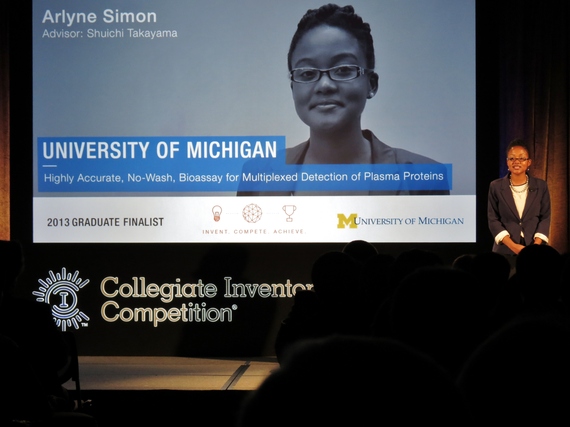Editor's Note: This post is part of a series produced by HuffPost's Girls In STEM Mentorship Program. Join the community as we discuss issues affecting women in science, technology, engineering and math.
Feeling like a true 21st century worker, as I telecommute from my home office -- my left hand holding an earl grey latte from an indie coffee shop, my right hand closing the tab of a "We the Geeks" Google+ Hangout.
The Hangout, "Don't Be Bored, Make Something," was infused with President Obama's challenge for Americans to be "the makers of things, not just consumers of things."
In thinking about what it means to grow a generation of makers, a simple and energetic statement I heard last week while interviewing finalists in the Collegiate Inventors Competition (CIC) came straight to mind. In response to being asked to share her thoughts with young girls on the topic of engaging in STEM (Science, Technology, Engineering and Mathematics) programs, one female engineering undergraduate shared, "It's essentially arts and crafts, but so much cooler... it's so much more useful."
I recognize that this analogy may make some scientists and engineers (and/or paper mâché enthusiasts) cringe a little, but it is a user-friendly message to share with the average 8-year-old girl who has likely had more experiences with clay, glue sticks and markers than with petri dishes, digital calipers and 3D printers. (Though that is likely to soon change.)
Here are a few more messages from the female CIC finalists that came through loud and clear:
Don't Touch That Bar!
These inventors stated that they do not want the bar to be raised or lowered, in regard to expectations around their performance in the field of STEM. They do not want to be held to a different standard (by themselves or others) than their male counterparts.
CIC graduate finalist from University of Michigan, Arlyne Simon, recounts:
"As a woman or minority in science and engineering , perhaps in the beginning you may feel a little bit intimidated...At first you may think, maybe you're just lucky. But then you realize, maybe through your parents and your peers that you're not lucky--you did this through hard work and you persevered and you succeeded, so you deserve to be there just as much as they do."
The Nature of STEM, Nurtured
Children are natural STEM-thinkers. They give us every opportunity to make enriched STEM learning an organic and enjoyable part of their lives.
CIC finalist from University of Utah (and third-prize-winning undergraduate team member), Jessica Kuhlman, recalls,
"...trying to build a sand castle right next to the waters' edge and it always falling when the waves would come. I really wanted the castle to have water flowing around it so I had to build up the sand nice and thick near the water so that I could still achieve the flowing water that I wanted."
Stella Latscha, CIC undergraduate finalist from University of Pennsylvania, links back to middle school, stating that she
"...had a sixth grade math teacher who really loved math puzzles and she'd give them to us and my parents both really encouraged me. They didn't tell me that I was doing well because it was really hard. They just said, (uses casual voice) 'oh yeah, that was awesome.' They didn't intimidate me and I think that led me down this path."
STEM Is Inescapable (in a Good Way)
"...everyone should have some handle on STEM. It is where the world is going. There is no one that should not be good at it," says CIC finalist from Johns Hopkins (and first-prize-winning undergraduate team member), Sandya Subramanian.
STEM is seamlessly integrated into our daily lives. It is the products we use, the technologies we engage with, and the planet we all walk upon. Our interactions with STEM are multifaceted and complex and we must all individually navigate the degree to which we make that relationship explicit.
World Changing
"...as engineers, we study the way that the world works, but also how we want the world to work," shares Elizabeth Beattie, a CIC undergraduate finalist from University of Pennsylvania and former Camp Invention participant. The collegiate inventors alluded to STEM as an empowering vehicle they are using to change lives (including their own).
Erica Skerrett, CIC undergraduate finalist from Rice University, conveys what it was like to see the expression of excitement on the face of a Malawian pediatrician to whom she was describing her team's invention. "It's incredibly rewarding. I always wanted to have a job that would help people. I also wanted a job, of course that I found interesting. Biomedical engineering is a perfect field for me."
More Than STEM
Several of the collegiate inventors wanted it to be known that STEM students are "regular people," as they gave examples of going out, having boyfriends and girlfriends, and playing sports.
Lauren Davis, CIC undergraduate finalist from University of Pennsylvania, recounts a story of a volleyball teammate's mother asking her, "...so, what are you going to quit first: engineering or volleyball?" From that moment forward, Lauren decided:
"I'm going to do them both. I'm going to do them for four years. I'm going to get it done. I just look at it as such a challenge, to kind of break into this field and prove everyone wrong. You just can't let anything small, any failure, anyone telling you no, stop you from doing that."
Once the country has readjusted its manufacturing bar to respond to the president's challenge to be "makers of things," be sure to leave it exactly where it is for our nation's next generation of female inventors, innovators and entrepreneurs. They are ready to take on the challenges that face them and "get it done."
